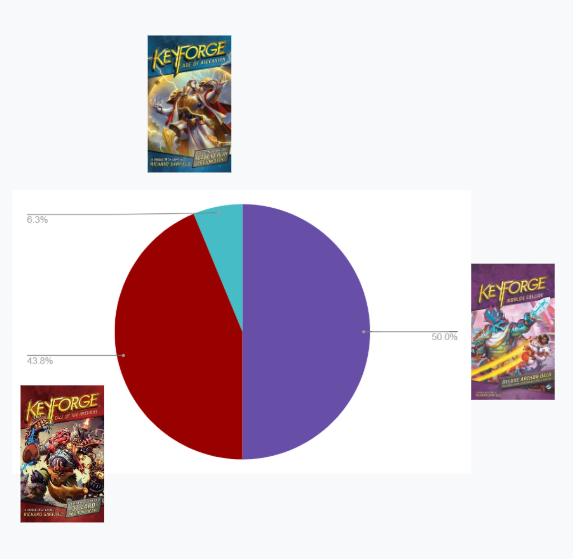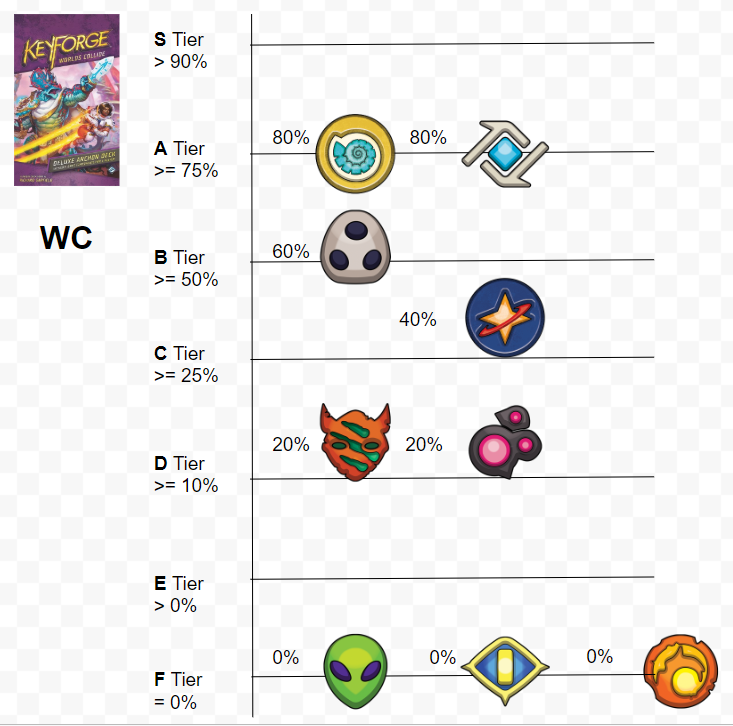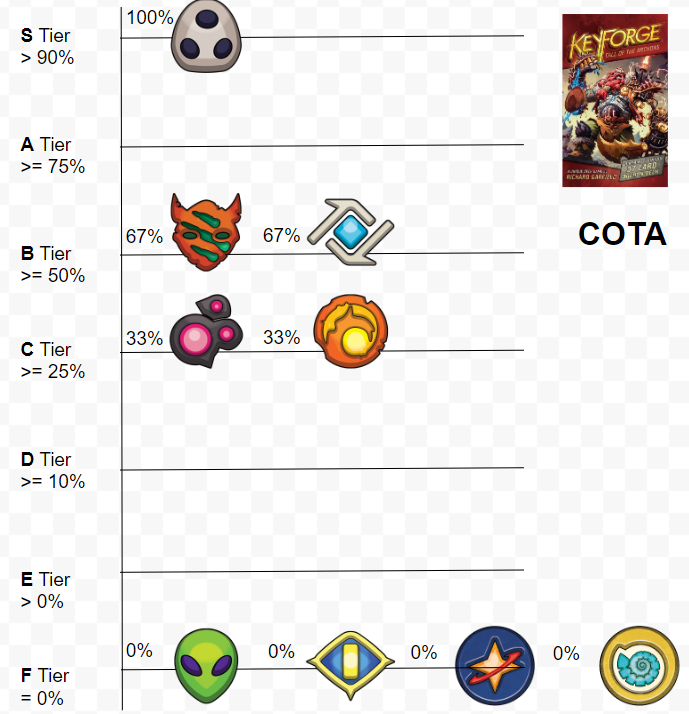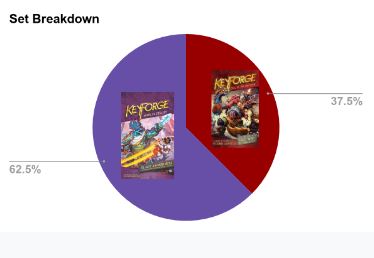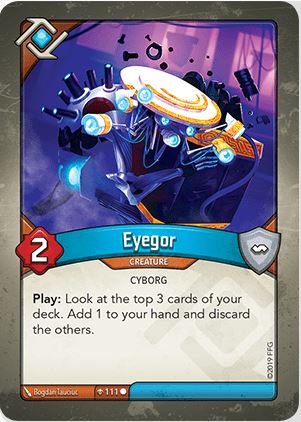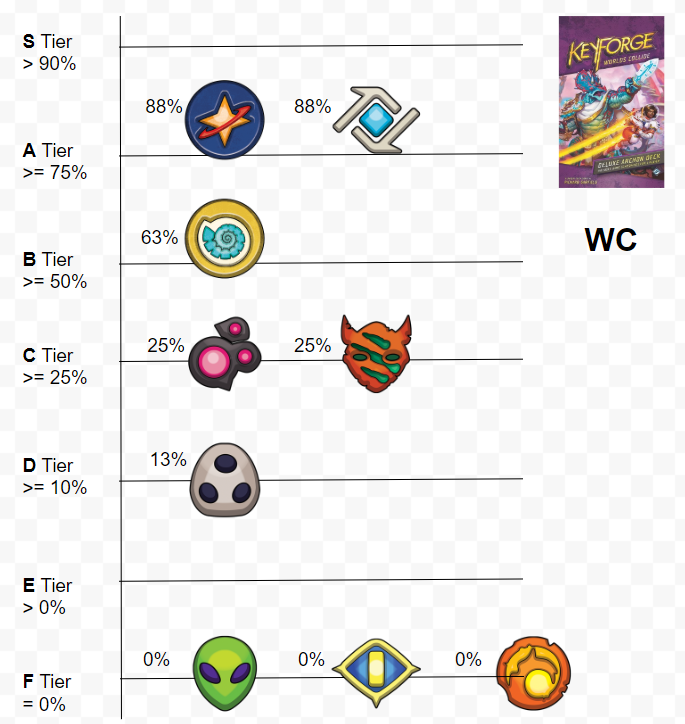
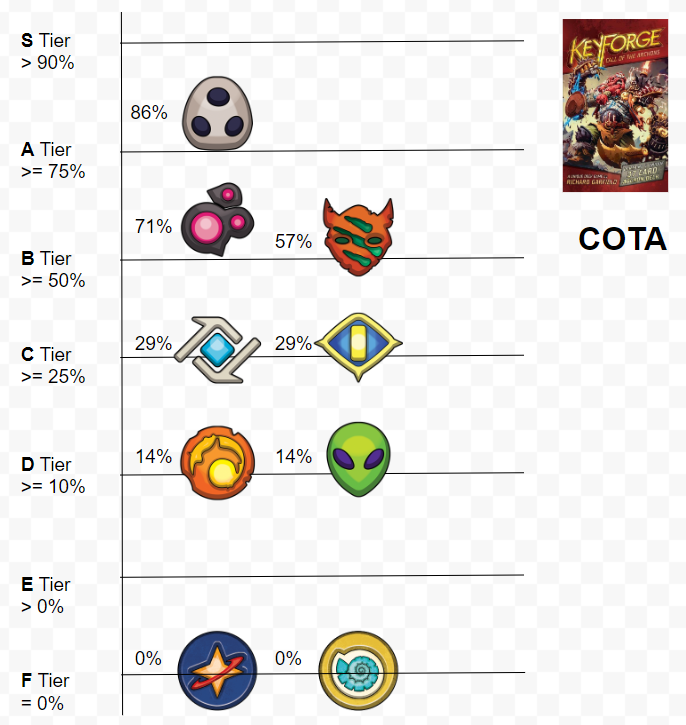
Albany, NY Archon Vault Tour
Have you ever wondered which decks are good enough to compete at the highest level? My goal is to address this by answering the following questions for you:
- How powerful is each house in the current meta?
- How powerful is each set in the current meta?
- What are the top cards to look for in a successful deck?
- How high of a SAS and/or AERC rating is required for a deck to be considered elite?
- What is the AERC profile of an elite deck?
- Which deck archetype/s are currently playable at the highest level?
- How do I identify an elite deck?
This analysis is all based on the top cut decks from the Archon format at the Albany, NY Vault Tour on January 10-12, 2020.

https://archonarcana.com/2020_Albany_Vault_Tour
The top cut for this vault tour was the traditional number of 16 decks. Special thanks to Lady Caffeina for gathering the data from the vault tour.
TL:DR – Scroll to the very bottom for a summary of an elite deck’s profile.
1. How powerful is each house in the current meta?

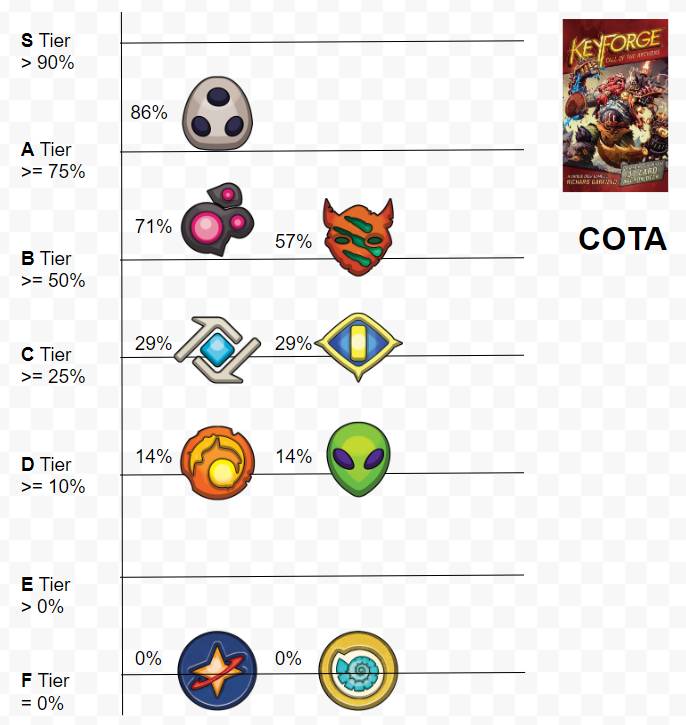
To try to answer the question of how powerful each house is in the current meta, I looked at the percent representation of each house in the top cut at the vault tour. The criteria I decided upon for each tier is:
- S tier > 90%
- A tier >= 75%
- B tier >= 50%
- C tier >= 25%
- D tier >= 10%
- E tier > 0%
- F tier = 0%
Let’s look at each set separately. I will not include AoA (set 2) here due to it only appearing once in the top 16. However, I will dive into why I felt that particular deck was successful. Let’s start with World’s Collide (WC) since it had the highest representation in the top cut.
WC Changes from Last Vault Tour:
- Saurian: A → B
- Logos: A → A
- Shadows: B → D
- Star Alliance: C → A
- Untamed: D → C
- Dis: D → C
- Brobnar: F → F
- Mars: F → F
- Sanctum: F → F
COTA Changes from Last Vault Tour:
- Shadows: S → A
- Untamed: B → B
- Logos: B → C
- Dis: C → B
- Brobnar: C → D
- Mars: F → D
- Sanctum: F → C
- Star Alliance: F → F
- Saurian: F → F
WC Analysis:
In the first screenshot above, we can see that there are no houses currently in the S tier. However, 2 houses VERY narrowly missed this distinction, Logos and Star Alliance, coming in at 88% usage as A tier houses. Both houses have extremely strong cards in the common slots and both houses enable your deck to operate more efficiently, whether this is card draw and archive with Logos or house cheating with Star Alliance. It seems as if it is difficult to open a WC deck that has a weak Logos or Star Alliance lineup. These houses also produce great lineups that don’t tend to require specific groupings of cards to synergize in order to be successful.
Saurian is the lone house in the B tier at 63% usage. This makes sense as there are many powerful Saurian cards. Although most Saurian lineups are at least average, it seems harder to open a truly elite Saurian lineup compared to Logos or Star Alliance. This is because whatever the lineup is trying to do requires synergy among its own house. This may take the form of building and maintaining a strong board, filling your Saurian creatures with exiled or captured ember to buff your creature power, sending aember back to the common supply, forging keys, or exiling creatures to your opponent to ‘pop’ like “Dino Pinatas” as Dan from the Sanctumonius podcast likes to call them.
Crassassaurus is the epitome of Saurian. It captures a combination of 10 aember from both you and your opponent combined. This is the ultimate risk reward, because while you may have pulled your opponent off of check for a turn, all they need to do is destroy Crassassaurus to get all of that aember into their pool, unless…something prevents that from happening. You could protect Crassassaurus with big taunters or ward so that your opponent has trouble killing it. You could use effects like Praefectus Ludo or Imperial Scutum so that when Crassassaurus dies, the aember goes to the common supply instead of your opponent’s pool. You could use cards that buff power based on aember such as Tribune Pompitus. You could use the aember on Crassassaurus to forge keys such as with Imperial Forge, Senator Bracchus, Senator Shrix, or The Callipygian Ideal. You could even exile Crassassaurus to your opponent and then kill it, sending all of the aember to your pool. Each of these strategies requires different cards to set up, requiring synergy to pull off successfully.
Untamed and Dis are the 2 houses occupying the C tier, both at 25% usage. Untamed is focused mainly on bursting aember with cards like Song of the Wild and Ghosthawk, or board control like Nature’s Call, Caldron Boil, Unnatural Selection, Mimicry, Kangaphant, as well as Anga and Jaga Panpaca. Dis is focused on disruption as usual, particularly in the form of purge in WC. There is also a strong emphasis on board and aember control. Cards like Infurnace, Hysteria, Exhume, and Impspector make for strong Dis lineups.
Shadows has fallen to the D tier. It has some useful supporting cards such as Hock to remove artifacts and some aember stealing tools such as Too Much to Protect and Ronnie Wristclocks, but overall there weren’t too many strong additions to the house in WC. It does have a few board control tricks like Kymoor Eclipse and Inky Gloom to pair with a handful of creatures that capture or steal aember.
There are no houses in the E tier, but Brobnar, Mars, and Sanctum are all in the F tier at 0% usage. Given that Mars and Sanctum don’t exist in WC (outside of legacy mavericks), this isn’t surprising to see them here. However, Brobnar is in the set and still had 0% usage in the top tier. Unfortunately Brobnar is in a bad place, focused mainly on fighting, but without any real way to generate much aember while doing so (unlike in the previous sets, albeit in limited ways: i.e. Ganger Chieftain, Drummernaught or Warsong, War Chest, Loot the Bodies, etc…) There are a few aember loss mechanics, but they seem difficult to execute and may add unnecessary chains. Personally I feel if Brobnar is going to be the fighting house, there need to be more effects to gain aember when fighting.
COTA Analysis:
It should be unsurprising that Shadows sits at the top spot for COTA due to its many powerful steal effects as we can see in the second screenshot above in the A tier at 86% usage (4% below S tier).
Dis is still clearly the second most powerful house in COTA with its myriad of board clearing, aember stealing, and turn disruption cards. Dis comes in at 71% usage and shares the B tier with Untamed, coming in slightly lower at 57%. COTA untamed is famous for extreme burst. Think Dust Pixie, Fuzzy Gruen, Nature’s call, Fertility Chant, Hunting Witch, etc…
The C tier is occupied by Logos and Sanctum, both at 29% usage. Logos has some elite power with the right lineups in COTA, but it is much more difficult to have a top tier Logos lineup in this set compared with WC. Sanctum does many things well, but nothing great. It has beefy creatures to hold down a board and protect smaller creatures with taunts or shields. Many of its creatures can capture aember to stall the opponent. Sanctum can also burst with cards like Virtuous Works, Cleansing Wave, and Oath of Poverty.
Bronar and Mars both come in at 14%. Both houses have potential to produce strong lineups, particularly Mars, but finding decks with elite lineups of these houses is quite rare. Bronar would likely need lots of board control cards like Cowards End or aember control cards like Burn the Stockpile. Neither option fits what Brobnar wants to do which is fight. There are, however, a few cards to make Brobnar burst when it fights. Mars is totally dependent on Mars. A good Mars house synergizes well with itself and ignores the other houses. It would do things like massive draw of Battle Fleet paired with Key abduction, or have multiple creatures that ready each other and perhaps even a Crystal Hive to reap for extra aember.
Star Alliance and Saurian are once again at 0% usage as they don’t exist in COTA.
AoA Analysis:
AoA actually had 1 deck make it into the top cut, finishing impressively in the top 4! This is still very low representation so it is hard to glean much about AoA itself. I think this particular deck’s success is more about the AERC profile than AoA specific cards. Let’s take a look.
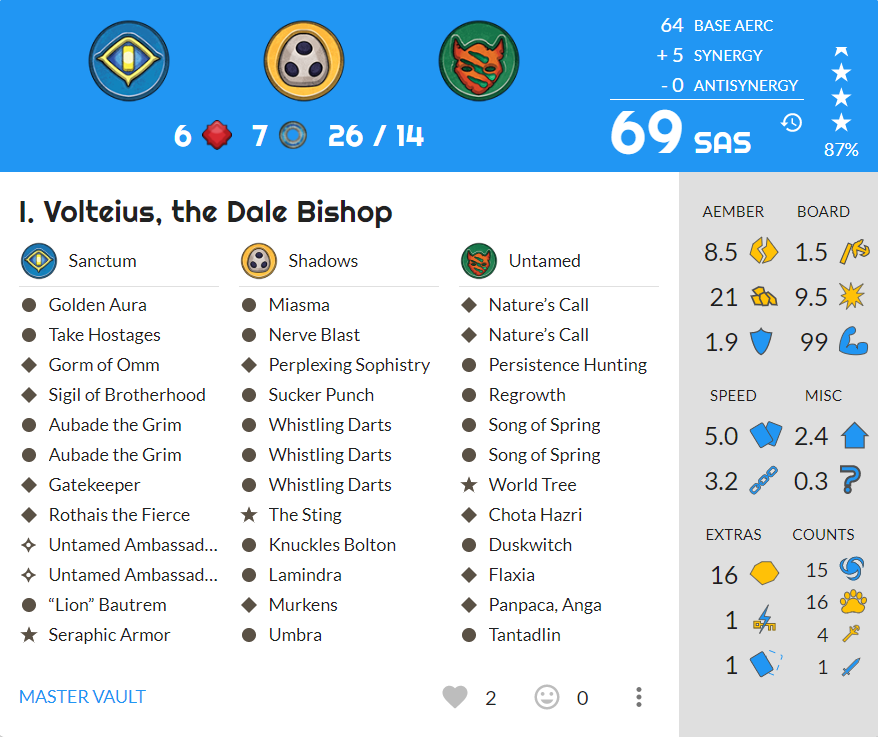
https://decksofkeyforge.com/decks/3eb00a5a-2b6d-4cdd-bcd7-e365b7b3c834
On the surface, if you just looked at the SAS and AERC without worrying about the houses or set, you would see an extremely balanced deck. It has good aember control, good board control, good aember generation (The Big 3 must haves). It also has artifact control, good creature power, decent efficiency, decent disruption, great raw aember, a key cheat, and a way to archive. (The Gravy nice to haves). There is absolutely no weakness to this deck when looking at AERC alone. In addition, the deck has a 0 for antisynergy. We are looking at a spectacularly balanced deck.
Digging deeper we can see some solid pieces. It has a beefy Sanctum main house that can hold down the board, capture aember, and house cheat. Those double untamed ambassadors off of a duskwitch could do some serious work. The double Nature’s Call is very powerful in this meta to remove big bodies from the board. It can also be used nicely to recur Chota, as can World Tree, Regrowth, and double Song of Spring. The Whistling Darts x 3 can pop wards and the Miasma can buy an extra turn.
TheNickOfSlots made an excellent point that one of the reasons efficiency (F) is so strong and prevalent in the current meta is because it leads to “decreased variance” or what I like to think of as “consistency,” meaning you can expect the deck to perform about the same way most of the time, rather than having to worry about the inconsistency of finding your answers to your opponent’s deck, which could be in your last few cards. Efficiency enables this by helping dig through your deck more quickly. Although this deck doesn’t have particularly high efficiency, I want to point out that this deck has 4 sets of doubles and 1 set of triples. I feel that duplicates also contribute to high consistency/decreased variance, because you are more likely to find your answers if there are more copies of them in the deck.
In the end I think this deck was successful not due to being in AoA, but despite being in AoA. It is just an incredibly balanced deck with many answers and almost no weaknesses, if any.
2. How powerful is each set in the current meta?
To try to answer this question, I looked at representation of sets among the top cut at this vault tour. Among the top 16 decks at Albany, 8 were WC, 7 were COTA, and 1 was AoA. This breaks down to: 50% WC, 43.8% COTA, and 6.3% AoA (rounded up). This is a fairly even split of WC and COTA that slightly favors WC. The general consensus still seems to be that WC and COTA are fairly equal in strength. We can clearly see that AoA is weaker, as it only appeared once in the top 16.
3. What are the top cards to look for in a successful deck?
I looked at the most commonly occurring cards in the top 16 decks, separated by set, to help us target which cards to look for in a successful deck. Now, it is important to realize that there is some bias here because not all cards have the same rarity. Therefore, a card that is common within a highly-represented house is more likely to show up for this reason than a rare card, even if it is not necessarily a strong card. It is also worth noting that 16 decks is a relatively small sample size when looking at something like individual cards from such a large pool of possibilities. My impression though is that when trying to analyze if a deck can be successful, keep an eye out for as many of these cards as possible. With this in mind, I present the most common cards in the top 16 based on the number of times each occurred:
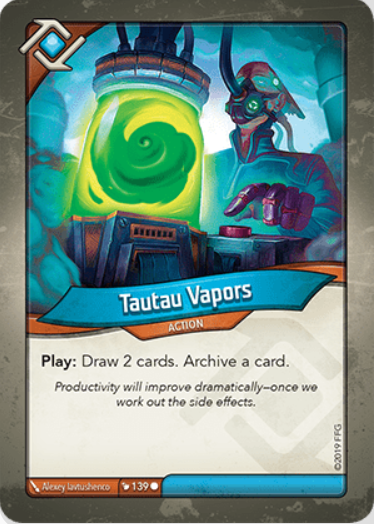
https://decksofkeyforge.com/cards?aercHistoryDate=&sort=SET_NUMBER&title=vapors
WC Card Usage:
- 8 x: Tautau Vapors
- 7 x: Com. Officer Kirby
- 6 x: Commander Chan, EDAI “Edie” 4×4, Eyegor, Stealth Mode
- 5 x: Cloaking Dongle, Cutthroat Research, Red Alert, Rhetor Gallim, Senator Shrix, Wild Wormhole
- 4 x: Exhume, Hollogrammophone, Medic Ingram, Sci. Officer Quincan, Tribune Pompitus, Tribute, Zap
- 3 x: Armsmaster Molina, Crassossaurus, Daughter, Harbinger of Doom, Light of the Archons, Phalanx Strike, Praefectus Luto

https://decksofkeyforge.com/cards?aercHistoryDate=&sort=SET_NUMBER&title=hunting%20witch
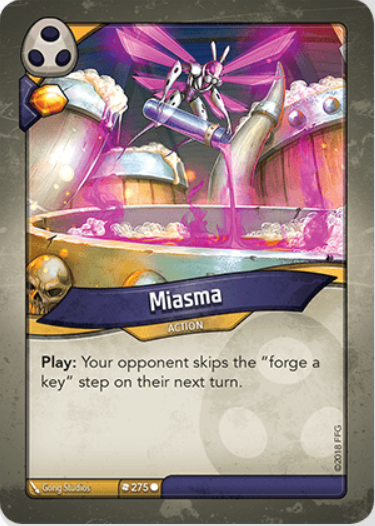
https://decksofkeyforge.com/cards?aercHistoryDate=&sort=SET_NUMBER&title=miasma
COTA Card Usage:
- 7 x: Hunting Witch, Miasma
- 6 x: Routine Job, Urchin
- 5 x: Ember Imp
- 4 x: Charette, Fear, Nature’s Call, Niffle Ape, Relentless Whispers, Stealer of Souls, Witch of the Eye
- 3 x: Bate and Switch, Control the Weak, Dust Pixie, Effervescent Principle,
- Gateway to Dis, Interdimensional Graft, Mother, Nexus, Poltergeist
WC Reaction:
- I’m not too surprised to see that almost all of the cards that occur 3 times or more in the top 16 decks are from the top 3 highest usage houses: Logos, Saurian, and Star Alliance. Eyegor and Tautau Vapors, both commons, are excellent for cycling through your decks. These were very high on the list last vault tour as well. Other Logos cards at the top of the usage list are EDAI “Edie” 4×4, Cutthroat Research, and Wild Wormhole. Edie helps archive and increases the opponent’s key costs, doing two things at once. Cutthroat Research, a weak card in the days of AoA, has new life, since there are so many ways to increase key costs and make it trigger for the 2 aember steal. Wild wormhole, though somewhat risky, grants aember, cycling, house-cheating, and the ability to help you pull the answer you are looking for, though it is a gamble. The risk can be mitigated by knowing your deck well and remembering which cards have not yet been played. Com. Officer Kirby and Commander Chan are great for house cheating and Cloaking Dongle can allow you to protect your board. Stealth Mode is identical to Scrambler Storm from Logos in COTA, but it has higher usage in a house that is almost always providing good house lists compared to the inconsistency of Logos in COTA. Rhetor Gallim, Senator Shrix, and Tribune Pompitus are all hugely impactful in terms of increasing your opponents keys, forging with exiled/captured aember, or building a powerful board. A Dis card, Harbinger of Doom, made it into the list, which goes to show the value of board wipes in the current meta of big, sticky boards.
COTA Reaction:
- The majority of cards in the COTA decks are well known at this point as extremely powerful cards. I won’t get into those in detail, but I’ll touch base on the cards that surprised me. Fear, Niffle Ape, Stealer of Souls, and Nexus. Fear has more value now than in the past, since bouncing creatures with aember on them, or creatures who are powerful is very valuable. Niffle ape, considered one of the worst cards in the game, is likely on this list due to how incredibly common it is in Untamed and how many Untamed lists were in the top cut. I do think it is slightly underrated though, since it can get around taunt and elusive to kill small creatures with powerful effects. Stealer of Souls adds a purge effect which has become more common and relevant in the current meta. Nexus is solid artifact control within the strongest house, which is likely why we see it in this group.
4. How high of a SAS and/or AERC rating is required for a deck to be considered elite?
SAS: 69-83
AERC: 63-78
Based on the top cut, we can see that the lowest SAS score was 69, just like last vault tour and the highest was 83, down from 85 in the last vault tour. For AERC, we can see that the lowest is 63, down from 64 in the last vault tour and the highest is 78, up from 75 in the last vault tour. These ratings are very similar to last time. While SAS and AERC seem to be quite accurate overall, suggesting that the higher the numbers the better, it also matters where the break down of those points are that factor into the SAS and AERC rating. For instance, does the deck have any glaring weaknesses? No deck can have everything. However, when looking at a deck and trying to determine if it can compete at the highest level, it will likely need a SAS of at least 69 and an AERC of at least 63. If it does not have these things, it will likely have too many weaknesses to compete. A possible exception is a combo or a racing deck that only cares about achieving a particular game plan to win, rather than worrying about stopping the opponent.
5. What is the AERC profile of an elite deck?
I’ll start by laying out the mean average for each AERC stat:
A:10.5 R: 1 F: 11.2
E: 22 C:8.2 D: 4.1
AP: 1.1 P: 92 HC: 1.7 O: 1.8
I’ll start by saying that these numbers were VERY similar to the last vault tour. The efficiency rating dropped a little bit and the disruption and power increased slightly. This data makes sense on the surface. A well balanced and successful deck will typically need a fair amount of (A) aember control, (C) creature control, and (E) expected aember. This has been widely accepted for as long as SAS and AERC has been around. It makes sense that these decks have some (R) artifact control to deal with the game warping effects of cards like Quixxle Stone, Fangtooth Cavern, General Order 24, Soul Snatcher, Lash of Broken Dreams and others. The stat that really stands out as surprising is the (F) efficiency rating, which has a high average of 11. This seems to be a new trend focused on decks that can cycle very quickly. As was pointed out on the Help From Future Self podcast I believe it was (though it may have been Sanctumonious, I listen to both religiously), having a high efficiency makes up for a lack of answers such as low aember or low creature control. This is because you will cycle fast enough to reshuffle your deck and use these answer cards more than once.
Next, let’s look at the minimum for each of these AERC traits:
A: 5 R: 0 F: 0.5
E: 15 C:4.3 D: 0
AP: 0 P: 58 HC: 0 O: 0
This data is also very similar to the last vault tour, though A and C dropped slightly, perhaps due in part to having more decks in the top cut. Since we are looking at the minimum viable AERC traits, we expect to see lower numbers. However, a deck with these minimum traits in all of these categories would be far too weak to compete competitively. There is still a focus on having a fair amount of (A) aember control, (C) creature control, and (E) expected aember, but these numbers are not overwhelmingly high. What’s more, we see certain traits sacrificed here, such as a lack of (R) artifact control, (D) disruption, (AP) aember protection, and (HC) house cheating. I like to think of these traits as nice to have luxuries, rather than must haves like (A), (C), and (E).
I have to stress though that not all decks play a balanced style and some can afford to have weaknesses in some of the areas above, presuming they excel in others. Combo-dependent decks and racing decks are more likely to have multiple weaknesses than a balanced control deck.
6. Which deck archetype(s) are currently playable at the highest level?
My impression of the top 16 decks is that they are mainly balanced aember control decks with very few deficiencies that they make up for with high efficiency. There are a couple that resemble racing decks, but they seem to lean heavily into a sub-type of aember control and do not sacrifice many important AERC traits, if any.
The Bouncing Deathquark podcast breaks decks down into 4 basic archetypes, though a deck may exist within multiple categories, or have a main category with a subcategory:
- Aember Control: focused on preventing your opponent from forging keys, constantly stealing, capturing, or forcing them to lose aember. Effects such as increasing the cost of your opponent’s keys or preventing them from forging would also be included in this deck type.
- Board Control: these decks focus on building a board with creatures that can stick, then using those creatures to fight and maintain a creature count advantage or reap to generate aember.
- Combo: these decks focus on trying to put together a specific combination of cards that enable the win condition. You may have heard of the old LANS/LART decks before Library Access was errated to purge after use. Before that was the case, a player could combine Library Access with Nepethe Seed or Reverse Time to play the Library Access multiple times, enabling a player to draw their entire deck into their hand at once. A less broken and still viable combo is GENKA, which involves Martian Generousity and Key Abduction, enabling a player to trade aember for drawing multiple cards and then forging a key for free. Other notable combos include: Witch of the eye, Dominator Bauble, Control the Weak or Double Tezmal with Rocket boots to lock a player out of the game. Drummernaught and Ganger Chieftain is a popular AoA combo as is Binate Rupture and Interdimensional graft.
- Racing/Rush: this has been a very successful deck archetype for a long time. It involves playing cards for aember and ignoring the board state. A typical racing deck has many cards with printed “raw” aember on them, and possibly a handful of cards that burst for multiple aember when played under the right conditions. They also may involve cards like speed sigil to make the first creature each turn come into play ready to reap for an aember or soul snatcher to make your creatures sources of additional aember when they die. It is worth noting that a deck does not need to have a high (F) efficiency rating to be considered a racing deck. It is also worth pointing out that since racing decks don’t focus much on stopping the opponent, they tend to have multiple weaknesses.
7. How do I identify an elite deck?
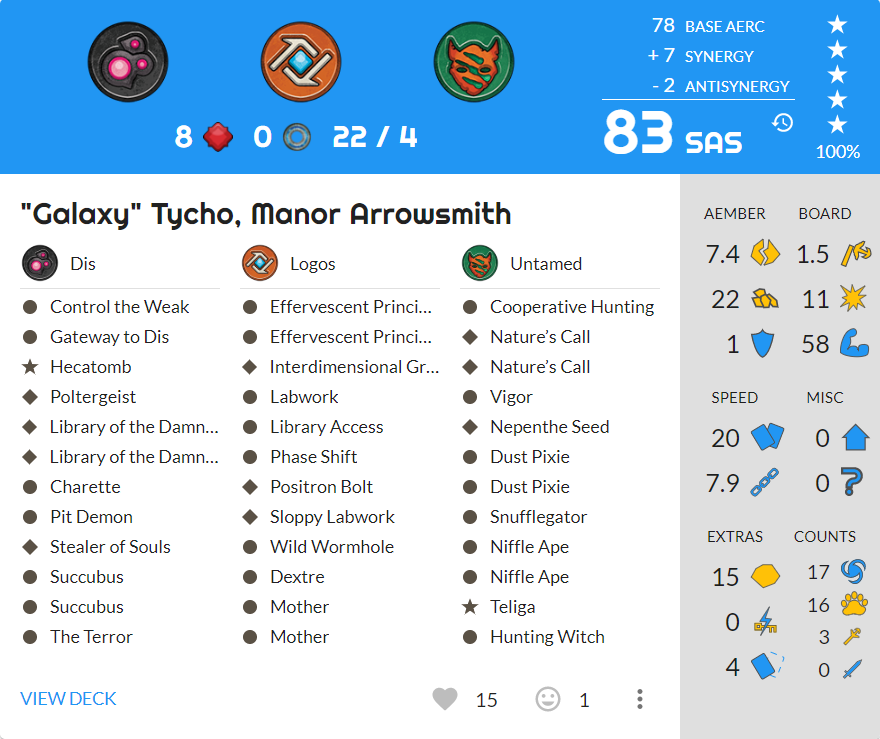
https://decksofkeyforge.com/decks?title=%22Galaxy%22%20Tycho%2C%20Manor%20Arrowsmith
Let’s put everything together to come up with the profile of an elite deck in the Archon format. You can search within your collection, or search decks that you are considering acquiring at Decks of Keyforge. Based on our findings above, an elite deck is likely to have the following characteristics:
- WC Houses: 2 or more from Star Alliance, Logos, and Saurian, possibly with 1 from Untamed, Shadows, or Dis
- COTA Houses: Shadows and Dis, plus 1 of Logos or Untamed
- Set: COTA or WC
- As many of the following WC cards: Tautau Vapors, Com. Officer Kirby, Commander Chan, EDAI “Edie” 4×4, Eyegor, Stealth Mode, Cloaking Dongle, Cutthroat Research, Red Alert, Rhetor Gallim, Senator Shrix, Wild Wormhole, Exhume, Hollogrammophone, Medic Ingram, Sci. Officer Quincan, Tribune Pompitus, Tribute, Zap, Armsmaster Molina, Crassossaurus, Daughter, Harbinger of Doom, Light of the Archons, Phalanx Strike, and Praefectus Luto
- As many of the following COTA cards: Hunting Witch, Miasma, Routine Job, Urchin, Ember Imp, Charette, Fear, Nature’s Call, Niffle Ape, Relentless Whispers, Stealer of Souls, Witch of the Eye, Bate and Switch, Control the Weak, Dust Pixie, Effervescent Principle, Gateway to Dis, Interdimensional Graft, Mother, Nexus, and Poltergeist
- SAS: minimum of 69, average of 77.3
- AERC: minimum of 63, average of 69.2
- AERC minimum traits:
- A: 5 R: 0 F: 0.5
- E: 15 C:4.3 D: 0
- AP: 0 P: 58 HC: 0 O: 0
- AERC average traits:
- A:10.5 R: 1 F: 11.2
- E: 22 C:8.2 D: 4.1
- AP: 1.1 P: 92 HC: 1.7 O: 1.8
- Deck Archetype: Aember control or Racing/Rush (with a focus on high efficiency)
Disclaimer: Just because a deck meets all of the criteria above, does not ensure that it will be an elite deck that is capable of competing at the highest level. This is merely guidance you can use in your quest to identify top-level decks. Please keep in mind that this is average data, therefore it won’t necessarily apply to all deck archetypes. Additionally, an AoA deck that meets all of the criteria above can be just as effective as one from COTA or WC. You are just less likely to find an AoA deck that meets these criteria.
